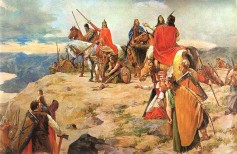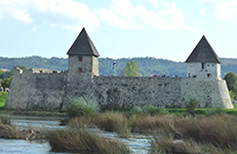Apr 04 2013
Categories: Nations
The Heirs of Stjepan Držislav
0The newly started war in Croatia resulted in occupation of Dalmatia by Venetians, led by doge Pietro Orseolo, and the same policy was continued by his son Otto. The new ruler Krešimir III and his coruler Gojislav were at first in good relations with Pietro Orseolo and Basil II, who's authority they formally acknowledged. But following the strengthening of opposition in Venice, regarding the hereditary policy of the Orseolos, Krešimir decides to invade Dalmatia, a move which would later prove to be hasted. In the fights against Basil II, Croats were assisted by Hungarians, and good relations to the northern neighbors were also preserved by Krešimir's heir Stjepan I. During Stjepan's reign, the function of Croatian bishop in Knin was reestablished.
Mar 21 2013
Categories: Nations
Stjepan Držislav
0After the civil war and Michael Krešimir II's twenty-year long reign, Držislav came to Croatian throne. Thanks to alliance and good relations to the Byzantine emperor Basil II Boulgaroktonos (the Bulgar-slayer), Držislav acquired jurisdiction over Dalmatia. There are two stone tablets preserved from his time from which we can see that there was a precise system of succession of government, however, a political split that had followed will have resulted in a dynastic disruption that would be resolved only 17 years later.
Mar 15 2013
Categories: Nations
Church Councils and King Tomislav’s Heirs
0Apart from the successful campaigns against the Hungarians and Bulgarians, where Tomislav had proven himself as an exceptionally good military strategist, his reign as a duke, and ultimately a king, was marked by two events that were important for the ecclesiastical history of Croatia. The events in question are two church councils in Split, in 925 and in 928. These events will be further discussed in this article. We will also mention Stjepan, Tomislav's heir, to whom he left a consolidated state, despite of a civil war that was going on at the time.
Mar 13 2013
Categories: Architecture
Medieval Castles
0Medieval fortifications are probably one of the most recognizable symbols of this period. Apart from defensive, they also had a residential purpose, thus, they often contain shapes that combine those two functionalities. Unfortunately, those preserved until today represent only a small portion of their original number.

